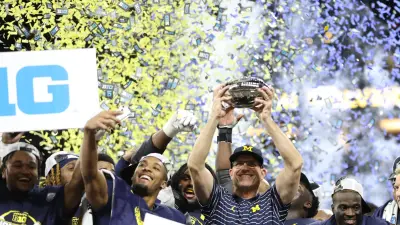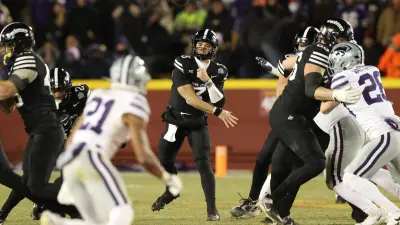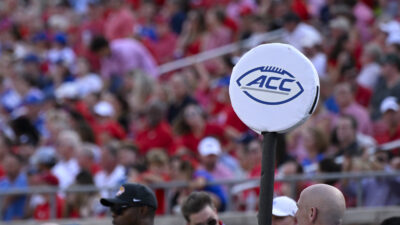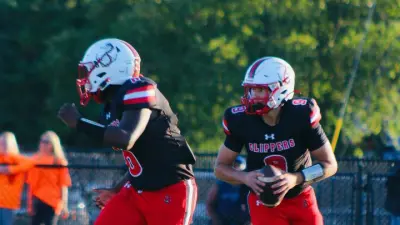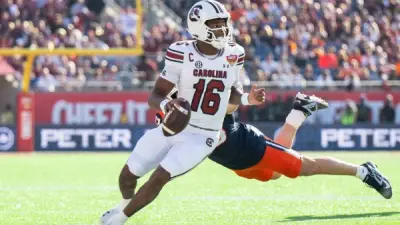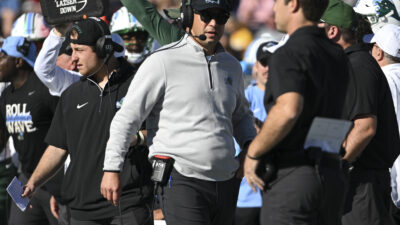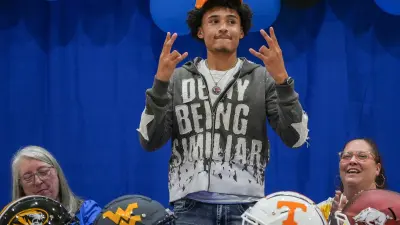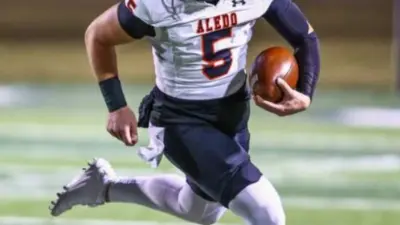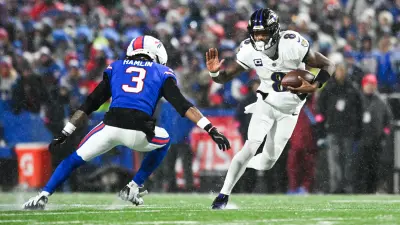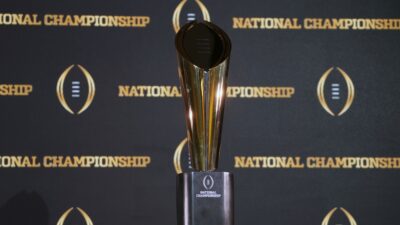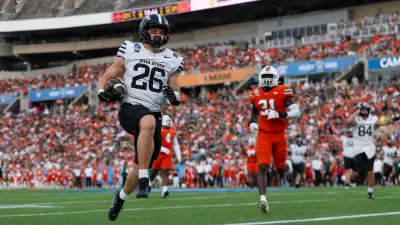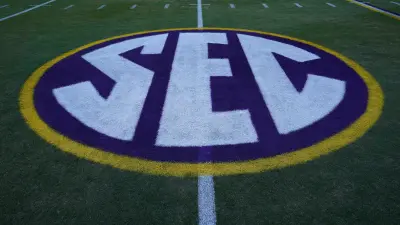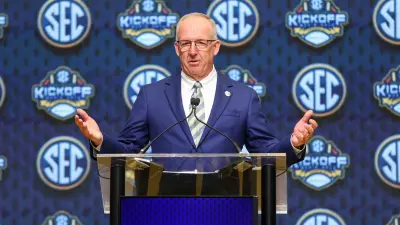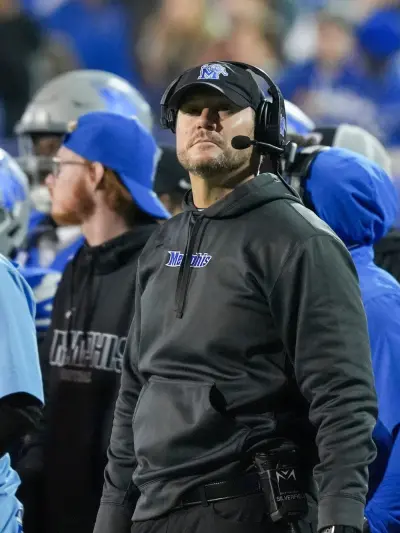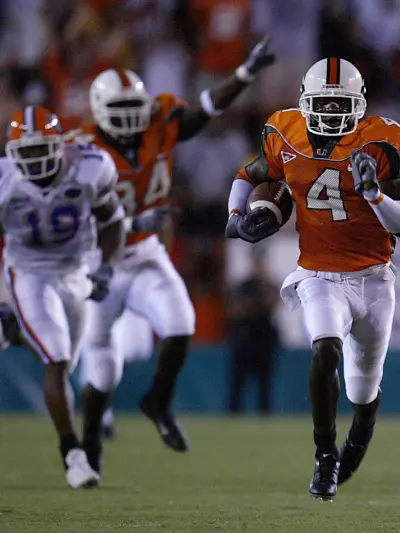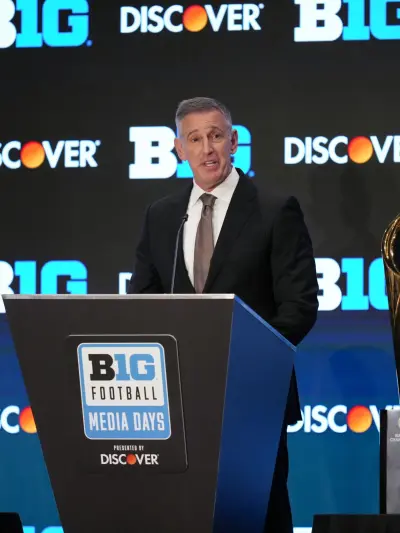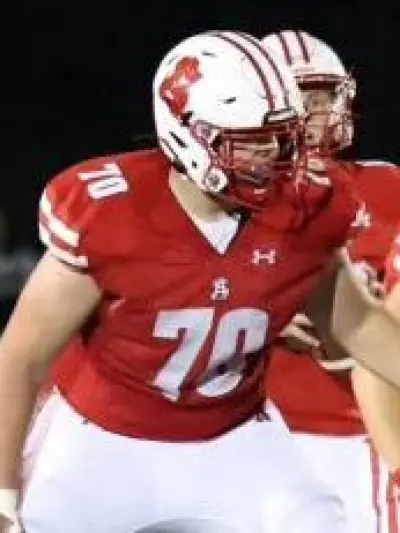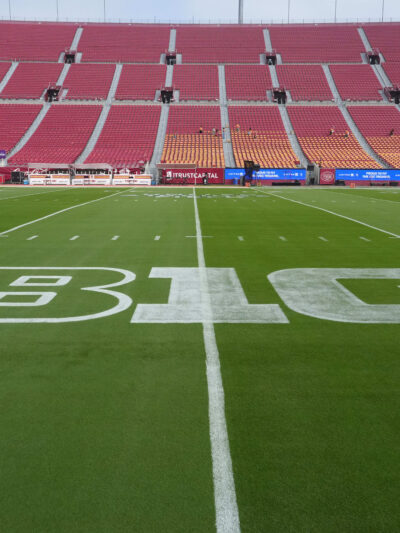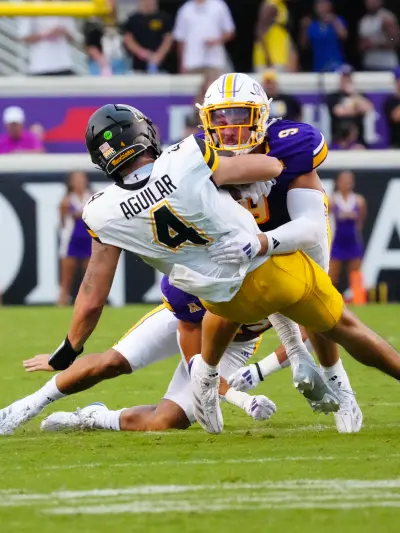College football in the near decade since the College Football Playoff’s inception has seen oligarchs in Alabama, Georgia, and Clemson be perennial powers. One-offs such as the 2019 LSU team and 2014 Ohio State have left significant impressions, and even the last BCS champion the 2013 Florida State Seminoles have left a giant imprint on the sport’s collective fabric.
But during the last decade, there have been programs that have vied for the national championship and just fallen short.
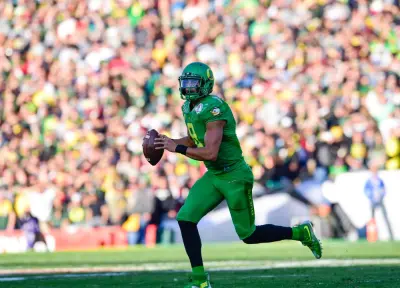
Oregon
The Drive For A Title
After Chip Kelly‘s departure to the Philadelphia Eagles in January 2013 left many wondering if Oregon could continue its dominance as the top west coast team. Kelly went 46-7, played in the 2010 BCS National Championship, and took home two New Year’s Six bowl wins in the Rose and Fiesta bowls.
Oregon for a third consecutive time promoted its offensive coordinator, Mark Helfrich (Kelly, and Mike Bellotti previously), as head coach. Helfrich inherited a stacked roster with quarterback Marcus Mariota, running back De’Anthony Thomas, wide receiver Josh Huff, offensive lineman Hroniss Grasu and Tyler Johnstone, defensive lineman DeForest Buckner, and defensive back Terrance Mitchell.
The Ducks entered the 2013 season ranked in the top three in the major polls, and Helfrich wanted to differentiate himself from Kelly in terms of how he orchestrated his offense. Kelly’s scheme is a very uptempo, no-huddle offense that was fast to do everything, Helfrich slowed down, became more balanced, and wanted to be more efficient all around.
While the 2013 Ducks got off to an 8-0 start and a No. 2 ranking in the polls, they were upended in Palo Alto against No. 6 Stanford. While not eliminated from the BCS National Championship picture, two weeks later, the Ducks’ championship dreams fizzled out in Tucson as unranked Arizona upset No. 5 Oregon 42-16.
More Sports News
The disappointment of 2013 fueled the 2014 season and it was a special one for Oregon. The 2014 Ducks won an early Top 10 matchup with No. 7 Michigan State at home in convincing fashion 46-27.
Their next focus was to avenge its humiliating loss in the desert from the previous season at home against Arizona. In a week where 11 teams were upset in the Top 25, it was a 21-point third quarter explosion by Arizona that Oregon couldn’t overcome as the Ducks fell again to the Wildcats 31-24.
Oregon would reel off seven wins in a row to set up a rematch with Arizona in the Pac-12 Championship Game and the Ducks wouldn’t be denied as they got up to a 30-0 lead before any response from the Wildcats as Oregon would clinch a spot in the inaugural College Football with a 51-13 win.
In the first-ever College Football Playoff game ever played at the Rose Bowl, the Ducks were dominant in the second half scoring a Rose Bowl record 41 points and ending the 29-game winning streak of the defending national champions Florida State in a 59-20 rout.
Arguably the signature play came from the Ducks’ defense in the phantom Jameis Winston fumble for a touchdown.
Falling Short of Glory
Oregon met Ohio State in the first-ever College Football Playoff national championship and they ran into a team of destiny. Unfortunately for the Ducks, they simply couldn’t match the intensity of an extremely talented Ohio State squad, featuring the likes of running back Ezekiel Elliott, defensive end Joey Bosa, and wide receiver Michael Thomas.
The 42-20 defeat slammed the door on a championship era at Oregon, as the scholarship reductions from the Kelly era began to rear its ugly head, especially on the defensive side of the ball.
The 2015 Ducks surrendered 42 points to FCS Eastern Washington to open the season and gave up 40 or more points in six contests and only had four games where they would allow less than 30 points.
Helfrich was terminated after a dismal 4-8 campaign in 2016 and the Ducks have had a rotation of coaches come in since with Willie Taggart, Mario Cristobal, and now Dan Lanning.
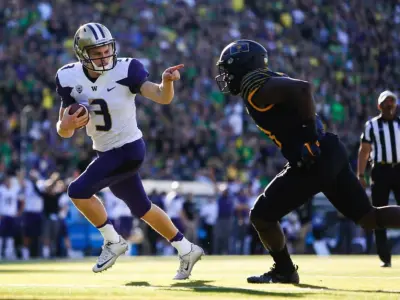
Washington
The Drive For A Title
After the abrupt resignation of “The Dawg Father” Don James in 1993, Washington had been trying to find stability and return as the dominant program in the Pacific Northwest. That time period saw the ascension of Oregon as a national power, so while Rick Neuheisel had the Huskies in the Top 4 in 2000, his lack of integrity ultimately led to his demise in 2003.
The Huskies went through a number of coaches following Neuheisel’s dismissal, including Steve Sarkisian before he jettisoned for Southern Cal. But they finally found success when they looked east to the state of Idaho. Chris Petersen, who won 88.4% (92-12 record) of his games at Boise State, including four Top 10 finishes and two Fiesta Bowl wins, was lured to Washington to restore the “Purple Reign” in Seattle.
During his first two seasons, Petersen had to close the talent gap between Washington and the rest of the Pac-12, but also contend with playing Oregon, Stanford, Utah, and Arizona, who all were Top 20 programs at the time.
In 2016, things began to click for the Huskies, and the nation took notice when the Huskies routed No. 7 Stanford at home 44-6 in a high-profile Top 10 matchup. While the euphoria of the Huskies’ biggest win since upsetting No. 3 Southern Cal in Steve Sarkisian’s first season at Washington, their fiercest rival still laid ahead.
Oregon, who was down off of the golden era from 2010-2014, still had managed to beat Washington 12 consecutive times and with the game in Eugene, it still left an uneasiness for the Husky faithful. Quarterback Jake Browning did something very uncharacteristic things on the opening score that was a sign of things to come that day.
From the one-yard line on first and goal, Browning kept the ball on a zone read and as he darted into the end zone, he turned to the defender and pointed, drawing a 15-yard unsportsmanlike penalty but it turned the tide in the game. Washington would end “The Streak” that day as the Huskies became the first team ever to score 70 points in Autzen Stadium as Washington continued their run at a national championship.
Falling Short of Glory
The high water mark for Petersen at Washington came that Selection Sunday when the No. 4 spot was in doubt. Washington was locked into a spirited debate with Big Ten foes Ohio State and Penn State vying to make the playoff. Penn State threw a wrench into things because they won the Big Ten championship and defeated Ohio State earlier in the season.
When the dust settled, Ohio State (No. 3) and Washington (No. 4) made the College Football Playoff. Washington’s “prize” for making it in was to take on Nick Saban‘s No. 1 Alabama team who had averaged over 40 points per game entering the contest and surrendering only 11 points per game.
Washington, who also boasted a Top 10 scoring offense and defense, was able to slow down the potent Crimson Tide offense, but offensively the Huskies couldn’t gain any momentum lost to Alabama 24-7.
While Petersen would guide the Huskies to two more New Year’s Six bowl berths, Washington got the Oregon problem again as the Ducks rebounded under Mario Cristobal with quarterback Justin Herbert realizing his potential.
They never won the big out of conference games whether it was against Penn State or Ohio State in bowl games or against Auburn in the Kickoff Classic. Washington never separated themselves talent wise against the pack significantly and this opened themselves to upsets against Cal or Arizona State.
Eventually Petersen tired from the rigors of coaching retired, Washington dealt with COVID and the Jimmy Lake error and with Kalen DeBoer now in Washington coming off the programs first 11 win campaign since the 2016 Huskies, things look bright for Washington.
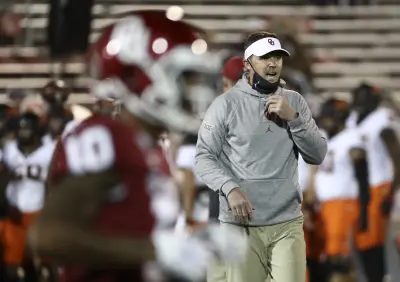
Oklahoma
The Drive For A Title
One of college football’s bluest bluebloods, Oklahoma possesses a trophy case that is the envy of most nearly every program in the country not named Alabama.
Bob Stoops earned the nickname “Big Game Bob” for winning many big games early in his tenure rejuvenating a program that hadn’t fully recovered after the fallout of the Barry Switzer era. Seemingly, though, after the upset by Kansas State in the 2003 Big XII Championship Game, it seemed Big Game Bob had a rough time in big spots for Oklahoma. Between the 2004 Sugar Bowl against LSU to the end of the 2014 season, Oklahoma was 11-23 against Power 5 competition that won 10 or more games, including going 0-3 in national championship games.
In 2015, Stoops turned to East Carolina offensive coordinator Lincoln Riley, who was a disciple of Mike Leach spending seven seasons coaching at Texas Tech from 2003 to 2009 learning his flavor of the Air Raid. Oklahoma turned it around in Stoops’ final two seasons winning five of seven against teams who won 10 or more games and made it to the College Football Playoff.
Following the 2016 season, Stoops retired and fully turned the reigns over to Riley. He inherited a team loaded on offense led by former walk-on and eventual Heisman Trophy winner Baker Mayfield, tight-end Mark Andrews, wide receiver Marquise “Hollywood” Brown and newcomer at wide receiver CeeDee Lamb.
The 2017 Sooners averaged 45.1 points per game and were extremely lethal offensively, defensive were middle of the road allowing 27.1 points per game. Oklahoma would make the College Football Playoff and play in the Rose Bowl against Georgia.
Falling Short of Glory
The 2018 Rose Bowl was one of the best games of the CFP era. With six seconds to go in the first half, Oklahoma went up 31-14, and it seemed destined that the Sooners would advance to their first national championship game appearance in over a decade.
After a short Austin Siebert kickoff, Georgia got into the range of Rodrigo Blankenship and he hit a 55-yard field goal to end the half, and as the teams entered the locker rooms Georgia head coach Kirby Smart pointed out that field was huge making it a two possession contest versus three and kept the Bulldogs in the game.
Smart’s words became reality as Georgia erased Oklahoma’s 14 point lead at the end of the third quarter and the defensive collapse was on for Riley, something that would continue to follow him. Oklahoma defense’s inability to make key stops doomed the Sooners that day as Sony Michel darted in on a 27 yard touchdown run to have Georgia advance to their first national championship game since their Sugar Bowl showdown with Penn State in 1982.
That game became a microcosm of the Lincoln Riley era in Norman. The Sooners would dominate the inferior competition early, but, as the competition grew tougher, Riley’s teams would either choke away games, or simply get annihilated in them like in the College Football Playoff semifinal games against Alabama and LSU.
While Riley arguably became the top quarterback coach in the country, with a resume that includes two Heisman Trophy winners that went No. 1 overall in the NFL Draft in Mayfield and Kyler Murray, a potential NFL MVP in Jalen Hurts, and current Heisman Trophy winner Caleb Williams who all seems destined to be a No. 1 overall pick, the Sooners never got impact players defensively to compliment its elite offenses.
At some point of time, Riley’s heart was no longer in Norman, and following the 2021 Oklahoma State game, Riley decided to become the next head coach at Southern California. Riley would leverage the transfer portal and poach Williams from Oklahoma amongst three Sooners who would go to Southern California.
New head coach Brent Venables never seemed to get the defense fixed or the offense to click as Oklahoma suffered their first losing season since the John Blake era, leaving fans in Norman wondering if they have the right man to guide their program as they soon will enter SEC play.
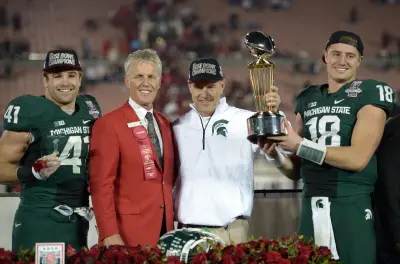
Michigan State
The Drive For A Title
After the retirement of Duffy Daugherty, Michigan State had been looking for a coach who could get the Spartans back amongst the nation’s elite on a consistent basis. When the they finally lured Nick Saban from the Cleveland Browns to East Lansing, he became committed to the program like no other coach had been since the Daugherty era.
Saban realized the commitment necessary to realize his vision to become a national powerhouse he realized that wasn’t going to happen at Michigan State and bolted for LSU. Michigan State had failed experiments with Bobby Williams and John L. Smith where they weren’t going to get Michigan State back to the top.
The Spartans turned to a familiar face who demonstrated the commitment to excellence the Spartans desired. Mark Dantonio, who spent time as Nick Saban’s defensive back coach at Michigan State and was Ohio State’s defensive coordinator for their 2002 national championship team, was hired from Cincinnati to become the next Spartans head coach.
Dantonio was a driven recruiter and began to win battles against a Michigan program who was beginning to slip under Lloyd Carr, and began rekindle the “Big Brother vs. Little Brother” feud in the state.
What hurt Dantonio early was the Big Ten’s unwillingness to have a conference championship game. While the Spartans won a share of the 2010 Big Ten conference championship with Ohio State and Wisconsin, it missed out on a BCS bowl berth at the time the limit was two teams in BCS Bowl minus the BCS National Championship game.
The Spartans reward was to take on a familiar face, Nick Saban and his Alabama team who was just victimized in “The Cam-Back” game in the Outback Bowl and the Spartans had a very forgettable performance as the Crimson Tide rolled that day 49-7.
While Michigan State would play and lose in the inaugural Big Ten Championship Game in 2011 to Wisconsin 42-39, Dantonio took advantage of Big Ten division alignment (no Penn State, Ohio State, or Wisconsin to deal with) and the fact Ohio State and Penn State were on NCAA sanctions with Michigan floundering in the Brady Hoke era.
Between 2013-2015 it was a golden era for Michigan State football, as the Spartans won two Big Ten Championships, two New Year’s Six bowl games, and make the College Football Playoff. During that span, Michigan State had two giant program defining wins against Ohio State that elevated the Spartans amongst the national elite.
In 2013, in a highly anticipated Big Ten Championship game, the No. 10 Michigan State made a critical defensive stop in the fourth quarter when linebacker Denicos Allen thwarted Ohio State’s Braxton Miller on a key fourth and two situation that prevented the Buckeyes getting a first down. The Spartans would extend the lead to 10 on a Jeremy Langford touchdown and put the game on ice for Michigan State for a 34-24 win.
The second game in 2015, is what took Michigan State to the next level nationally. The margin of error for Michigan was razor thin considering they had already lost to Nebraska earlier in the season and was without quarterback Connor Cook.
The Spartans 12th man that day was the elements, as it was cold and rainy and it slowed down the potent Buckeyes offense. Michigan State’s two-quarterback system of Damion Terry and Tyler O’Connor did enough on the ground to . They were supported by a ground attack that gained over 200 yards rushing and consumed nearly 40 minutes of time of possession.
It set up for a time expiring Michael Geiger field goal that gave Michigan State a 17-14 win and snapped a 23 game winning streak by Ohio State.
Falling Short of Glory
Michigan State won the 2015 Big Ten Championship against undefeated Iowa 16-13.
The game was left an ominous feeling around the Big Ten that either Iowa and Michigan State were legitimately elite and belonged to be in the Top 5 in the country or that they were vastly overrated. The concern of being overrated was realized quickly as Stanford rolled Iowa in the Rose Bowl 45-16 behind running back Christian McCaffrey‘s record of 368 all purpose yards.
For Michigan State, they again ran into Saban and Alabama in the Cotton Bowl. It was a very forgettable performance as the Spartans managed only 193 total yards and five first downs in a 38-0 loss to the Crimson Tide.
At the end of the 2015 season, Dantonio culminated a six-year stretch going 65-15, and winning a share of or sole possession of three Big Ten Championships, three New Year’s Six bowl berths, a College Football Playoff appearance, and an 8-3 record against Ohio State and Michigan.
Ultimately, what aided Michigan State was a favorable divisional alignment and the fact Michigan and Penn State were down.
With the hires of Jim Harbaugh at Michigan and James Franklin at Penn State, and their ability to recruit at an elite level, combined with Ohio State humming under Urban Meyer and Wisconsin finding their groove under Paul Chryst, Michigan State tumbled. When the Spartans awarded Mel Tucker his contract extension after a Peach Bowl win after the the 2021 season, it was out of fear that he would leave for LSU and potentially the program would slip back. Tucker and Michigan State had a tumultuous 2022 season and look to bounce back in 2023.
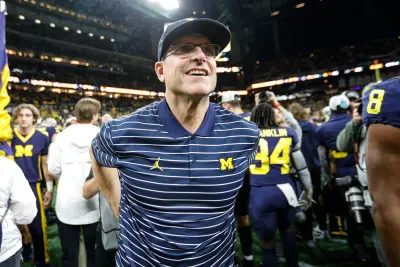
Michigan
The Drive For A Title
After the failed experiments of Rich Rodriguez and Brady Hoke, Michigan needed to match the hire Ohio State did a few years prior when they got Urban Meyer. With Jim Harbaugh becoming more disenfranchised with the NFL with the San Francisco 49ers, Harbaugh went to his alma mater to revive the program.
It was supposed to be a match made in heaven for Michigan, a Michigan man who was a disciple of Bo Schembechler, who had a proven track record in the NFL and at Stanford was going to revive the Maize and Blue.
Leading up to the first Meyer/Harbaugh showdown, fans had Bo/Woody “Ten Year War” vibes that was hyping it up. However, the thing most Michigan fans failed to realize was how far behind Michigan of getting back to national prominence and how far ahead Ohio State was in that regard.
It was a painful process getting Michigan back, and the most painful moment had to be the 2016 encounter between the arch rivals.
This was the strongest Michigan team since the 2011 team that defeated Ohio State, and a team that was vying for their first Big Ten conference championship since 2004. The Wolverines seemed primed for the upset and first signature win in the Jim Harbaugh era.
In double overtime, Michigan was clinging to a 27-24 lead and forced Ohio State to a fourth and one situation, on the controversial play Ohio State quarterback J.T. Barrett took the keeper and the debate between Ohio State and Michigan fans was the spot by the official.
The official marked Barrett at the 15 yard line which was good enough for the first down. On the ensuing play, Curtis Samuel goes untouched into the end zone to give Ohio State the win, it sent Penn State to the Big Ten Championship Game (a team Michigan humiliated earlier in the season 49-10), and left Harbaugh absolutely bitter.
Over the next four seasons, Harbaugh began to realize he didn’t have Michigan built in the way it needed to be in order to be successful. Harbaugh took the time to rebuild the trenches and have dominating offensive lines, have dominant ground games, with suffocating defenses.
When Harbaugh brought in defensive Mike MacDonald from the Baltimore Ravens, the attitude began to change on how to approach teams and Ohio State, the team Harbaugh failed to overcome again and again.
2021 was a banner year for Harbaugh, and flanked by MacDonald and eventual Broyles Award winner Josh Gattis at offensive coordinator, the tide began to turn for the Wolverines as they began to assert their will against the opposition. And none was more on display than the Ohio State game.
Against the Buckeyes, the Wolverines ran for nearly 300 yards and averaged over seven yards per carry, as Michigan snapped an eight game skid against Ohio State, and Ohio State’s 26 game conference winning streak 42-27.
Can Harbaugh get Michigan a national championship?
Michigan has appeared in back-to-back College Football Playoffs winning two Big Ten championships along the way. In the playoffs, Michigan continues to struggle against the nation’s elite.
In 2021, eventual national champion Georgia dominated Michigan and kept their ground game silent. Back in early January against TCU, the defense couldn’t stop the dynamic TCU offense led by Heisman finalist Max Duggan and future NFL wide receiver Quentin Johnston.
Since Michigan won their last national championship in 1997, the Wolverines have gone 2-7 in New Year’s Six/College Football Playoff appearances with their only wins coming in 2000 in the Orange Bowl against Alabama and 2012 Sugar Bowl against Virginia Tech.
Harbaugh continues to flirt with the NFL, even after shutting down the NFL last week, news has leaked Harbaugh continues to speak with NFL teams.
Jim Harbaugh announced he was returning to Michigan, but conversations with the #Broncos continued. Last week’s covert mission to Ann Arbor showed the door remains open on Harbaugh’s potential return to the NFL. More from @RapSheet and me: https://t.co/u37Fk1Ceik
— Tom Pelissero (@TomPelissero) January 29, 2023
It seems Harbaugh not knowing what he truly wants will block him from winning a national championship at Michigan. If he were to be 100% committed to Michigan, he has the blueprint to win the College Football Playoff.
He would need to recruit elite quarterbacks and wide receivers to complement an already elite offensive line and running backs. Until Harbaugh closes the door on the NFL, the door will remain closed for Michigan winning a national championship.
